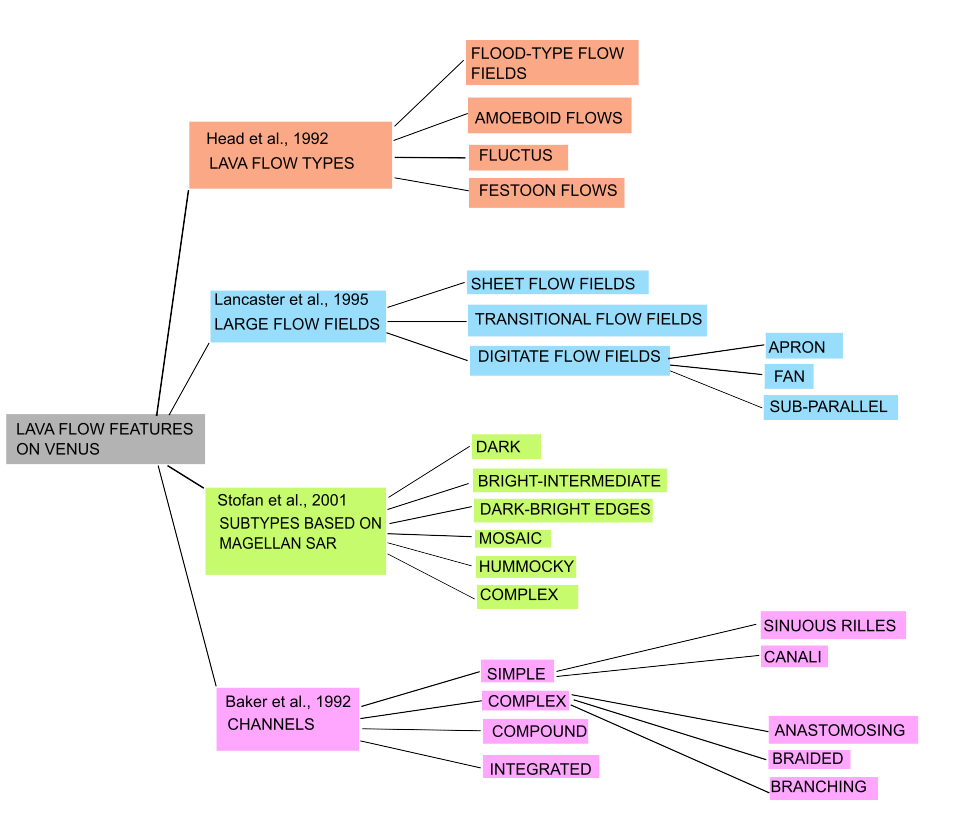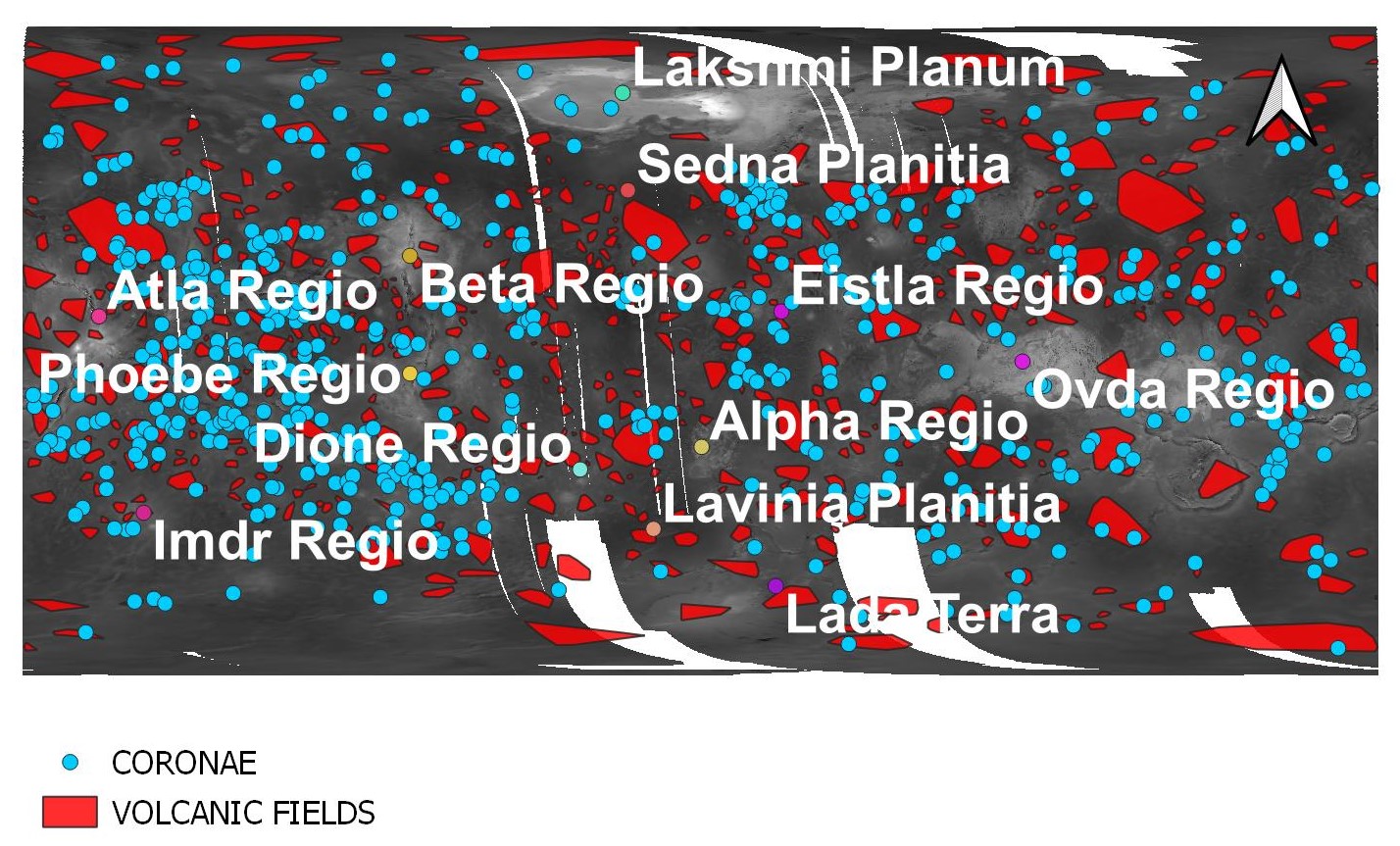Analysis of lava flow features on Venus for radar sounder simulations
- University of Trento, Remote Sensing Laboratory, Department of Information Engineering and Computer Science, Italy (lisa.molaro@unitn.it, lorenzo.bruzzone@unitn.it )
Introduction
Previous missions to Venus depicted an environment dominated by volcanic landforms and hostile atmospheric conditions. The surface was imaged by the Magellan mission, and compositional information were extracted from the Venera, VEGA and Venus Express missions. However, these data show low resolution and uncertain geologic correlation. To improve our knowledge, new missions towards Venus are planned, like ESA’s EnVision. EnVision will study the surface and subsurface of Venus and its relationship with the atmosphere with various instruments, among which a subsurface radar sounder (SRS). SRS will operate at a central frequency of 9 MHz with a bandwidth of 5 MHz, penetrating for few hundred meters through the subsurface, with a vertical resolution of about 20 m [1]. One of SRS targets are lava flow features. This work analyses the existing literature related to lava flow features on Venus, to extract morphometric and compositional information to improve the SRS performance prediction through simulations based on geological analogues. This approach exploits existing radargrams in geologically analogous terrains to produce realistic simulations of the investigated target, using parameters related to the composition and morphometry of the target [2].
Lava flows properties and distribution
Several classifications for Venus flows are based on morphology and radar backscatter (Figure 1). These morphologies are then compared to terrestrial common effusive features: pahoehoe, a'a, and blocky. Pahoehoe interpretation prevails based on Magellan radar backscatter of Venus flows, panoramas of the Venera landing sites and comparison with terrestrial lava flows, with values of rms slopes at Magellan SAR resolution of 75 m ranging from 2.5° to 8° [3]. Estimates of flow thicknesses from Magellan altimetric data and stratigraphic relationships span from 10-30 m to 400 m [4]. The extension of flows ranges from tens up to thousands kilometres.

Figure 1: Classifications of lava flow features (elaboration from [5], [6], [7], [8]).
The composition of lava flows inferred by previous missions and morphological observations suggest a predominantly mafic composition, mostly tholeiitic and alkali basalts (Table 1) [9]. Predicted values of porosity are lower for Venus than Earth, varying from 0.05 to 0.75 (bubble volume fraction). More exotic compositions for channels are considered, such as carbonatite or sulphur, and more evolved compositions are possible. Emissivity measurements of Venus flows range from 0.7 to 0.9, consistent with basaltic samples [3].
Table 1: Characteristics of Venera and VEGA landing sites from [9].
|
Landing site (Lat°, Long°) |
Geochemistry |
Inferred porosity |
|
Venera 8 (-10.70, 335.24) |
Very high K, Th, U |
- |
|
Venera 9 (31.01, 291.64) |
Low K, U; high Th |
- |
|
Venera 10 (15.42, 291.51) |
Low K, U, Th |
1–7% |
|
Venera 13 (-7.55, 303.69) |
High K basalt |
50–53 % |
|
Venera 14 (13.05, 310.19) |
Tholeiitic basalt |
60–62 % (top layer)/ 50–53 % (below) |
|
VEGA 1 (8.10, 175.85) |
Low K, U, Th |
- |
|
VEGA 2 (-7.14, 177.67) |
Tholeiitic basalt; low K, U, Th |
13% |
Lava flows are associated with volcanic edifices, rift zones and coronae. There is a concentration of these features in the Beta-Atla-Themis Regios and in Sedna Planitia (Figure 2) [6]. Comparing the probable composition of lava flows to that of their terrestrial analogues, geodynamic contexts for tholeiitic and alkali basalts would be consistent with Earth analogues like NMORB, islands arcs and hot spots, with melting occurring in the shallow mantle or at much greater depth. Carbonatite volcanism occurs on Earth in intraplate regions, on hotspots, associated with orogenic activity or plate separation, and is mantle-derived [8].

Figure 2: Map of Venus with major volcanic environments (elaboration from [10], [11]).
Conclusions
The analysis of the literature on lava flows on Venus is useful for both fine-tuning the expected performance of SRS on these features and defining scenarios to be accurately simulated. Considering lava flows compositional and morphological parameters, SRS is expected to be able to detect changes between flows based on composition, porosity, surface roughness and thus to provide a new stratigraphic perspective of Venus history.
References
[1] L. Bruzzone et al., ‘Envision Mission to Venus: Subsurface Radar Sounding’, in IGARSS 2020 - 2020 IEEE International Geoscience and Remote Sensing Symposium, Sep. 2020, pp. 5960–5963. doi: 10.1109/IGARSS39084.2020.9324279.
[2] S. Thakur and L. Bruzzone, ‘An Approach to the Simulation of Radar Sounder Radargrams Based on Geological Analogs’, IEEE Trans. Geosci. Remote Sens., vol. 57, no. 8, pp. 5266–5284, Aug. 2019, doi: 10.1109/TGRS.2019.2898027.
[3] B. A. Campbell and D. B. Campbell, ‘Analysis of volcanic surface morphology on Venus from comparison of Arecibo, Magellan, and terrestrial airborne radar data’, J. Geophys. Res. Planets, vol. 97, no. E10, pp. 16293–16314, Oct. 1992, doi: 10.1029/92JE01558.
[4] K. M. Roberts et al., ‘Mylitta Fluctus, Venus: Rift-related, centralized volcanism and the emplacement of large-volume flow units’, J. Geophys. Res. Planets, vol. 97, no. E10, pp. 15991–16015, 1992, doi: 10.1029/92JE01245.
[5] M. G. Lancaster et al., ‘Great Lava Flow Fields on Venus’, Icarus, vol. 118, no. 1, pp. 69–86, Nov. 1995, doi: 10.1006/icar.1995.1178.
[6] J. W. Head et al., ‘Venus volcanism: Classification of volcanic features and structures, associations, and global distribution from Magellan data’, J. Geophys. Res. Planets, vol. 97, no. E8, pp. 13153–13197, 1992, doi: https://doi.org/10.1029/92JE01273.
[7] E. Stofan, ‘Development of Large Volcanoes on Venus: Constraints from Sif, Gula, and Kunapipi Montes’, Icarus, vol. 152, no. 1, pp. 75–95, Jul. 2001, doi: 10.1006/icar.2001.6633.
[8] V. R. Baker et al., ‘Channels and valleys on Venus: Preliminary analysis of Magellan data’, J. Geophys. Res. Planets, vol. 97, no. E8, pp. 13421–13444, 1992, doi: https://doi.org/10.1029/92JE00927.
[9] A. Abdrakhimov and A. Basilevsky, ‘Geology of the Venera and Vega Landing-Site Regions’, Sol. Syst. Res., vol. 36, pp. 136–159, Jan. 2002, doi: 10.1023/A:1015222316518.
[10] R. M. Hahn and P. K. Byrne, ‘A Morphological and Spatial Analysis of Volcanoes on Venus’, J. Geophys. Res. Planets, vol. 128, no. 4, p. e2023JE007753, 2023, doi: https://doi.org/10.1029/2023JE007753.
[11] E. R. Stofan et al., ‘Preliminary analysis of an expanded corona database for Venus’, Geophys. Res. Lett., vol. 28, no. 22, pp. 4267–4270, 2001, doi: https://doi.org/10.1029/2001GL013307.
How to cite: Molaro, L. and Bruzzone, L.: Analysis of lava flow features on Venus for radar sounder simulations, Europlanet Science Congress 2024, Berlin, Germany, 8–13 Sep 2024, EPSC2024-836, https://doi.org/10.5194/epsc2024-836, 2024.